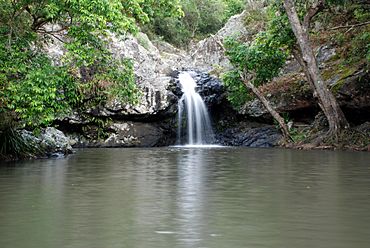Kondalilla National Park facts for kids
Quick facts for kids Kondalilla Tops National ParkQueensland |
|
|---|---|
|
IUCN Category II (National Park)
|
|

Pool above Kondalilla Falls
|
|
| Nearest town or city | Mapleton, Queensland |
| Established | 1945 |
| Area | 3.27 km2 (1.3 sq mi) |
| Managing authorities | Queensland Parks and Wildlife Service |
| Website | Kondalilla Tops National Park |
| See also | Protected areas of Queensland |
Kondalilla National Park is a beautiful natural area in South East Queensland, Australia. It is about 91 kilometers north of Brisbane. A man named William Skene first found this area while looking for lost cattle. He called it Bon Accord. Later, he gave it to the Queensland Government. In the 1950s, the name changed to Kondalilla. This is an Aboriginal word that means "running water."
The area was first protected in 1906 as a place for people to relax. It officially became a national park in 1945. You can easily get to Kondalilla National Park by road from Flaxton, which is east of the park. There is a big picnic area with toilets. However, the water there is not safe to drink.
The park has two main walking paths. One path leads to a swimming hole at the top of the falls. A longer path goes to the bottom pool, but you cannot swim there. The longer path takes about two hours to complete. Some parts of this path are close to cliff edges and do not have fences. You are not allowed to camp inside the park.
Contents
History of Kondalilla National Park
The Bonyee Festival: An Ancient Gathering
For many, many years, the Blackall Range has been a special place for Aboriginal people. This area has many bunya pine trees. These trees produce lots of nuts, which were a very important food source. Every three years, when the bunya nuts were ready, the Kabi Kabi and Wakka Wakka people held a big festival. It was called the Bonyee Festival.
Many guests traveled long distances to join the festival. They shared food, songs, and dances. They also arranged marriages and did other social things. A large grassy area near Baroon Pocket was a very important meeting spot for these gatherings.
Early Settlers and Logging in the Blackall Range
From 1842 to 1860, the Blackall Range was a protected area. Governor Gipps made it illegal to settle or cut down trees there. This was to protect the bunya pines for the local Indigenous groups.
After 1860, the rules changed. Farmers and loggers started to come to the area. In the 1880s, valuable trees were cut down. These included red cedar, white beech, bunya pine, blackbutt, and tallowwood. The forest around Kondalilla was heavily logged. You can still see the marks from these old logging practices today. Many forests were cleared as more people settled. However, some small areas were saved for people to enjoy nature.
Kondalilla Becomes a National Park
People started visiting this area in the early 1900s. They loved its "natural scenery, waterfalls, and amazing views." Kondalilla was the first part of the area to be protected. In 1906, it became a recreational area. Then, in 1945, it officially became a national park.
Over the years, more land has been added to the park. This helps protect the remaining natural areas. Kondalilla National Park (327 hectares) was connected to Obi Obi National Park in 1988. With other additions, the park has grown to 1591 hectares.
Mapleton Falls (26 hectares) became a national park in 1973. It had been a reserve for recreation for 38 years before that. Mapleton National Park (10064 hectares) was created on March 28, 2014. It combined Mapleton Forest Reserve and Delicia Road Conservation Park.
Animals of Kondalilla National Park
Kondalilla National Park is home to many different animals. You can find 107 different kinds of birds here! The park also protects a very rare animal called the Pouched frog. This special frog is not found in many other places.
A vulnerable plant species, the Macadamia integrifolia, also known as the Bopple Nut, also grows in the park.
Plants of Kondalilla National Park
The park protects a special type of forest called subtropical rainforest. This forest has many unique trees and plants. You can see tall piccabeen palms and trees like pink ash, hoop pines, and casuarinas. There are also eucalypt forests.
One of the most interesting plant features is a group of bunya pines. This is the most easterly group of bunya pines in all of Australia.
Walking Tracks for Visitors
There are two main walking tracks in Kondalilla National Park.
Picnic Creek Circuit (Easy Walk)
- Distance: 1.7 kilometers
- Time: Allow about 45 minutes
Kondalilla Falls Circuit (More Challenging Walk)
- Distance: 4.7 kilometers
- Time: Allow about 2 hours
See also
 In Spanish: Parque nacional Kondalilla para niños
In Spanish: Parque nacional Kondalilla para niños


